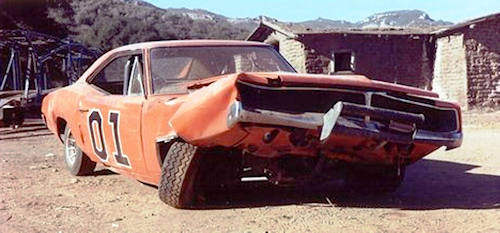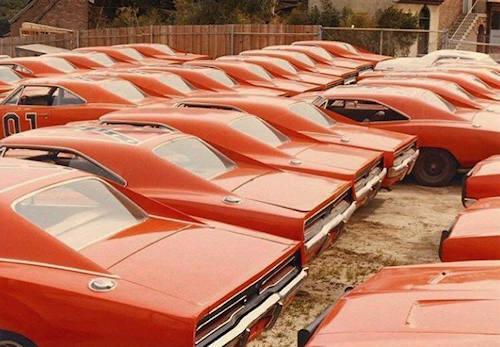It's not often that battlefield merit makes a soldier a popular hero. Here, perhaps only Garibaldi managed to win the admiration and affection of an entire nation recently united under the Savoy. In the USA, where people are always ready to mythologize, even a skilled secessionist general, Robert Edward Lee, found himself giving his name to a legendary car, the undisputed star of a very successful television series.
It was the legendary 80s when on the first private TV networks the images of an orange car and the sound of its horn emitting the opening notes of the anthem of the Confederate States of America conquered viewers. It was the debut of the 147 episodes of the television series "The Duke of Hazzard", an action-comedy that we titled Hazzard which told the amusing adventures of a nice family of whiskey smugglers who with their legendary Dodge Charger R / T challenged the Georgia police with daring escapes. Writing about it takes me back in time, that is to that adolescent spectator fascinated by the jumps that the car took to sow the sheriff on duty.
The general"

The TV series, written and directed by Gyneth Markley and Jerry Elijah Rushing, triumphed in each episode of the escapes of the smugglers Bo and Luke driving the orange car named "General Lee" in honor of Robert Edward Lee, general of the secessionist southern states Americans.
It is not clear if the action-comedy, set in a southern state, wanted to pass some message of revenge of the losers on authority.
Today Hazzard would be considered not politically correct? It is certainly an American like the most recent series of Supercar where the distinction between "good and bad" is however clear and the champions of justice are the creators of the talking black super Pontiac. However, it is more interesting to know the backstage of the film by Hazzard made in Covington city of Newton County (Georgia), in fact the county of Hazzard does not exist.
Only after several episodes did the crew choose to transfer the shooting to Warner Bros in Los Angeles.
The Dodge Charger R / T
The protagonist of the series is her, one of the most powerful racing cars in the USA in the 60s / 70s, the Dodge Charger R / T, (Road / Track) which, like Ford Mustang, Oldsmobile 442, Chevrolet Camaro and Pontiac Firebird, represented the concept (completely opposite to the European one) of muscle car overseas.
 Its two-door coupé line of yesteryear is undoubtedly the strong point, as is the orange paint, although its racing characteristics are only valid for the American Nascar circuits. Hence the idea of letting the protagonists enter through the windows as in the race, without using the doors which, in reality, were not blocked in the General Lee. Innovative for the time were the American Racing model alloy wheels Vector, the use of the roll cage interior and the front bull bar, placed precisely to perform their task and not for cinematographic aesthetic needs.
Its two-door coupé line of yesteryear is undoubtedly the strong point, as is the orange paint, although its racing characteristics are only valid for the American Nascar circuits. Hence the idea of letting the protagonists enter through the windows as in the race, without using the doors which, in reality, were not blocked in the General Lee. Innovative for the time were the American Racing model alloy wheels Vector, the use of the roll cage interior and the front bull bar, placed precisely to perform their task and not for cinematographic aesthetic needs.
Big displacements and lots of torque
Although in the last twenty years the American engines have come closer to the European motoring concept, the large volumes expected for the Dodge (and not only) were characterized by excellent reliability offering an ideal compromise to be coupled to hydraulic automatic transmissions, where the immediacy of the couple was a fundamental requirement.
For these characteristics of "tirelessness", the engines of historic brands today merged into Stellantis NV, General Motors Corporation, Ford and Caterpillar have also equipped tanks and trucks: Chrysler V6 215 HP, V8 RB440 7,2 cc for M113A1, Ford GAA and GAF V8 for the Sherman M4A3, Continental R6602 6-cylinder for M62 trucks.
Structure and performance

Aesthetically, nothing to say for an American car from the late 60s, but the Dodge's almost five and a half meters long and almost two tons of PTT. Charger they all feel on the track as evidenced by the test on the ISAM track in Anagni (Fr) per newsauto (newsauto.it - General Lee test). The interior is very spacious and those who are short in stature hardly reach the pedals. The engines can be 8-liter Hemi V7,2 (hemispherical combustion chamber) for 425 hp with four-body carburetor (4 carburettors, one every two cylinders) while the lightest used for scenographic jumps is a 5.2 hp 318 adds a 8 hp Chrysler RB V440 375 Magnum. The test reported to the media was carried out instead with a fourth engine, a 6.6-liter a little too lazy.
The type of engines preferred a maximum power that can be reached at low speed which means a formidable torque that pushes right from the start. The rigid rear axle with leaf springs and shock absorbers is not very sporty which, in addition to imposing a greater height from the ground to the vehicle, determines the disadvantage of leaving many and heavy suspended masses.
Excellent front independent suspensions that allow a lower center of gravity to the disadvantage / advantage of oversteer with the rear. Indeed on snow and ice the Dodge Charger The '70 R / T is practically undriveable also considering its engine torque.

Difficult to follow a precise trajectory on the track and to center the rope point on the ISAM circuit. The softness of the suspension and the excessive roll of the structure send you out of line, and if you accelerate you oversteer, then turning is not difficult at all.
Slow in the passages and in the kick down the three-speed automatic transmission (planetary-converter), obviously without control units and equipped with a centrifugal regulator at the output of the transmission for managing the valve box, the Valve Body. Better the four-speed manual, but let's be lenient without forgetting that we are talking about an icon now fifty years old.
300 Charger for the General Lee
That's right, 300 were needed and (maybe) a dozen survived. The Hazzard script was clear, at least two cars were destroyed in each episode. At the start of production, all the Covington workshops were contracted out, working day and night to reorganize the Charger and rearrange them mechanically, at the same time a frenzied search for Charger used on the American market.

All types of displacements and colors were fine, so much was the orange paintwork the first step of the production and, in some episodes, the shades of orange were even different.
In some scenes we notice the option of the gearbox on the steering wheel compared to the central tunnel rather than the manual or, the steering wheel and the interior in different colors. So today it is really very rare to find on the second-hand market. The stuntmen gave instructions to ballast the trunk to compensate for the weight of the engine especially during the jumps, in these scenes the “lighter” units with a smaller engine were used.
The cars were divided according to the type of scene, identifying the best ones for the foreground scenes and the others for the county dirt tracks or the stunts. Some were cut transversely and applied to a film oscillator to shoot from the cockpit with the projection of the road in front. The scenes with the Dodge moving on two wheels instead involved modifying the differential.
However, Covington began to no longer be the ideal terrain for the Hazzard episodes and production moved to Los Angeles. To safeguard some General Lee from the junkyard, Warner Bros also used models on plastic models that faithfully reproduced the county of Newton and, if you have never noticed anything, it means that they were really good.
Photo: web












